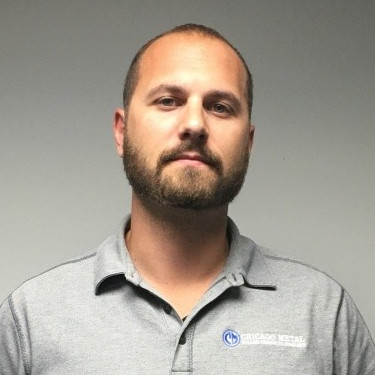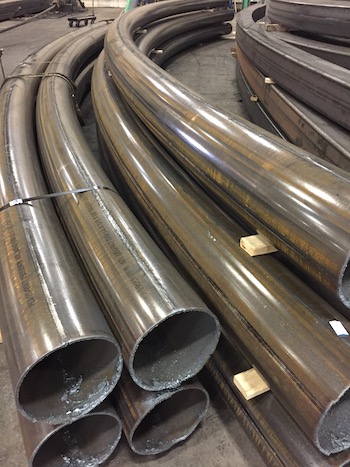Insights Into the Art and Science of Bending Hollow Structural Sections
Engineer Perspective: Ken Pecho, sales/project engineer & technical operations of Chicago Metal Rolled Products
We sat down with Ken Pecho, sales/project engineer & technical operations of Chicago Metal Rolled Products, to discuss his insights and experience with bending hollow structural sections (HSS). He shares the importance of getting bender rollers involved early to ensure a smoother process, discusses distortion, and advises finding a mentor to grow in the industry.
Q: Could you walk us through your background and career path to your role at Chicago Metal Rolled Products?

I’ve spent all of my career at Chicago Metal Rolled Products. It’ll be 18 years coming up in July. In college, I really wasn’t sure what I wanted to do, but I was really good at art. One day, in the middle of painting class, there was a bunch of noise and blue flashing light that I could see over the wall partition. I peeked into the room and there was a gentleman welding a steel sculpture. Right there, the light went off. I asked him where he got the welding equipment, and he told me he got it from the engineering department. I went back to my class, gathered up all my stuff and my teacher asked, “Ken, what are you doing?” I said, “I’m changing my schooling path.”
Long story short, I studied engineering with a focus on metal fabrication and manufacturing. After I graduated, my father drove me to look for a job and that’s where I found Chicago Metal. After a few years of estimating in sales, I decided that an undergraduate degree wasn’t enough for me, and I felt that getting my master’s degree would be something that would be beneficial to my career path. It was quite a journey, but here I am.
Q: What are the standards for bending steel for both fabrication and design? Do these include guidance for bending HSS specifically?

There are publications out there with guidance on the design and the fabrication of curved metals, and they do highlight specific areas of standards and specifications for hollow structural steel. One, which is fairly new in the industry, is AISC Design Guide 33: Curved Member Design. It was published by the American Institute of Steel Construction, which I played an important role in assisting with its content, along with the main author Bo Dowswell. He brought his understanding of design criteria and we incorporated practical examples, so it gives an excellent explanation of standards and guidance in both design and fabrication.
There is another publication called “Pipe Bending Methods, Tolerances, Processes and Material Requirements” by Pipe Fabrication Institute. It is PFI standard ES-24. They go through all the different methods and processes for bending tubes, pipes, HSS, what the tolerances are, what to consider if you have any distortion, and ultimately what is acceptable.
Another good resource comes from Tube and Pipe Association International that really dives deep into induction bending, which is a hot bending process that was initially invented for the oil and gas pipeline industry where bends need to be made on larger hollow sections and tight tolerances need to be kept.
Again, these publications give great practical, real-world guidance, but it all comes down really to the contractual documents. There’s guidance out there, but ultimately, it is really what’s agreed upon for the contracted job.
Q: Are there other resources you would recommend to designers and/or project teams for more information on bending HSS?
Yes, there’s a handful. If you start looking at the ISO, International Organization for Standardization, they have their own set of qualifications, specifications and procedures that you would have to abide by. Or you could seek information from them, but obviously you’d have to be ISO certified. There are a few others from ASME, American Society of Mechanical Engineers. There’s ASME B31.9, which talks about bending pipes or tubes for building systems, and there’s B31.8 that talks about distribution piping and gas transmission lines.
The tolerances and the considerations when looking into a specified bend or a curve really has to do with the use of this pipe. What industry is it for? Is this aerospace? Is this chemical? Is this structural? What is the intended use for it? Is it a pressurized application? Is wall thinning or ovality a concern? That’ll really tell you what you have to abide by in terms of how to process that and what type of quality standards you have to stick up to.
Q: Can you provide insight into the process involved in curving HSS?

There are many ways to curve HSS, but the most difficult part of bending HSS sections is the internal support. So how do we bend this without completely crushing it or distorting it to a point where it’s unusable?
Mandrel Bending
The mandrel bending process is a pretty straight and simple method. As long as you have the correct tooling, die set and set up for the machine, the member to be bent is clamped into that bending die and that is rotated to the specified degree of bend with a mandrel inserted into that pipe or tube. Again, these machines are well versed at making pipe spools multiple bends with tangent specific straight links in between them. You could do different planes of bend on them. These are ways to detail the severity of the radius of the bend. These style machines work really well for it. But they require a very specific set of tooling, and that tooling can be expensive, especially as the diameter of the tube or pipe gets larger. You can imagine after being in business for over a hundred years, like Chicago Metal has, our tooling catalog is extensive.
You could go out to our shop and you might look around and say, “Hey, you have two machines for this type of bending or three machines, but you have hundreds and hundreds of dies.” It’s because these dies are very specific, but you can get a very nice bend in the realm of 1D, 2D and 3D. 1D being extremely difficult, and the larger the Ds get in terms of center line radius the easier that bend gets.
One product you might be familiar with is bollards, pipe bollards. If you go to a gas station, you pull in, you see these pipes sticking out of the ground, and sometimes they have two straights sticking up that just looks like a U-shape. That’s the type of bending you get with rotary draw bending and is also a common way to bend.
Other Common Bending Methods
Another common way typically seen for a structural application, is called rolling, where you’re not really bending or wrapping the pipe around a die. You’re rolling the pipe back and forth and successively changing the geometry and the location of those dies or those rolls. As you bend the material back and forth through the tooling of the machine, you get successively tighter and tighter.
It all depends on the industry, the radius and the geometry of these bends. The reason why bender rollers are so special is because we have a ton of machines. We may have one machine that will cover a certain product range or a certain breadth of radiuses, but if we get beyond that, we have to move to a different type of machine or a different type of bending to be able to make a quality bend.
Q: What are some of the greatest challenges you face with bending HSS?
The greatest challenge with bending hollow section tubes, pipes, is the cross-section distortion. It’s being able to make a quality bend without putting the material into a form where it’s unusable. Each company has their own proprietary way of overcoming these challenges to make a successful bend. The challenge in bending HSS members is how to support this member internally while we are bending it? Some machines already come like that from the manufacturer. A rotary draw bend machine 100% will come with a mandrel fixture that will allow you to insert a mandrel into the inside of the tube when you’re bending to prevent the crush or collapse of that tube.
Regardless of the bending process or what machine you’re using, we have to be cognizant of the fact that when we bend this material, it’s going to deform. We can anticipate which way it will deform because we have a good idea of the forces that are acting on the member. We could predict what will happen, and in doing so, we could be better suited to think of how we can support this hollow structural section internally.
You could fill a pipe or a tube up with sand and compact that sand and cap off both ends. Sand will work sometimes, but sand likes to move on you if it’s not compressed. Any movement of the sand internally could be detrimental to the bend because you could get concavity, a dent, dimple or distortion. It’s not easy to fill a tube up with sand either. It’s not a foolproof way.
Chicago Metal Rolled Products sometimes will do what’s called sleeving. We will take other smaller members, usually tubes, rectangular or square, and we will stuff the inside of the larger HSS member with these smaller tubes, and we’ll roll it that way. Unfortunately, it’s permanent and definitely adds weight to the member. It’s good to keep in mind that if you see something specified from a bender roller that says this has internal sleeving or permanent tooling, it may be the only method to be able to achieve such a tight radius on a large member or a member that is formed in multiple different planes.
Ultimately, what we’re trying to do is provide material to the customer that is as close as possible to the nominal material that came in from the supplier or the mills. The mills are producing materials to a certain mechanical specifications, yields, elongations and tensile strengths, and they’re also producing those to a certain ASTM specification, like A500, that talks about tolerances, wall thicknesses and straightness tolerances. Although those standards don’t really apply to us because we’re bender rollers and we’re not the mills, we still try to abide by these standards as closely as possible.
Q: In your experience, what are ways that the design and specification of HSS can contribute to a smoother bending process?
I think one thing we constantly push for in this industry is early involvement. We want to be involved in that meeting, that conversation before this job even is contracted, before this job is even realized. If you can make it easier for the bender roller, it’s going to be a smoother and cheaper process.
But if you can’t get involved early in the process, one rule of thumb to remember is that very large HSS rolled really tight are always going to spell possibilities for a disaster.
Q: A common question we receive is about the minimum bend radii for HSS and whether dimensions should be referenced to the centerline or inside radius. What insights can you provide on this?
Again, what is this curved member used for? If we’re going to ask the question of should I be specifying my radius to the inside centerline or outside, I think I could give a pretty good example. We know that regardless of what process you use, when you bend HSS, you’re going to have cross-sectional distortion. It’s how well can we control that in a favorable way.
If I know that this is for a member that is involved in trusses for a roof design, I would probably want to specify the outside face final dimension because you might have some corrugated roofing deck on top, or you have some other members that need to mate or be attached to that outside face of that tube. If you specify an outside radius and you know that that member’s going to shrink, you would rather have the outside radius held. The inside portion could reduce in width, but we’re still holding that outside radius. Whereas if I held an inside radius and the tube’s going to shrink, then we might be short on the actual radius. It’s really for every application, which radius is critical for your design and your intent and use.
Q: What would you say is an acceptable amount of distortion in curving HSS?
I think the industry standard in terms of distortion is up to 5%. Some standards may go up as high as 8%, but anything over that is concerning. The human senses are fantastic for being able to determine if your member is going to be accepted or rejected. In AISC Design Guide 33 published by Bo Dowswell, there is guidance there in terms of how we assess if a member that has distortion in it should be accepted or rejected. In my mind, not every distortion is a term for rejection. Some distortion is a controlled distortion.
Q: When you join projects post-bid and encounter value engineering proposals, do you have preferred recommendations for AEC teams to control costs in bending HSS?

Typically, it comes in with regard to the member specified in the AISC Design Guide 33. There are some suggestions that certain HSS members perform better than others when bending in certain orientations or certain geometries. I also think of ideas for the AEC team to make it easier on us. One way is not having to invest in tooling that may only be used for one job. Tooling is expensive and time-consuming.
Q: Could you describe notable HSS projects you’ve worked on and what contributed to their success?
One of the most notable projects I’ve worked on in the recent past is called The Sphere in Las Vegas. It’s pretty remarkable what they’ve done. Another notable HSS project that I was involved in was the Atlanta International Airport. To make projects like that a success we needed attention to detail.
You may get involved in a very large project where you’re receiving material from multiple different mills or the same mill staggered throughout a year or so of work. We know that these are coming off of different heats or melts, different runs of the same tube. Although it may seem like not a big deal, every heat, run of a material out of a mill, mechanicals, etc. are different. So paying attention to these and how the material comes in from the mill and saying, “Hey, these bundles were for one heat and these bundles were for another,” and separating them into groups will really help with the success of a project.
Q: Could you share your involvement in any committees or teaching roles that you find most rewarding for personal and professional growth?
I’ve had the opportunity to work with the AISC Bender Roller Committee, and I did help Bo Dowswell in certain ways to put together that Design Guide 33. I also just gave a presentation at NOMMA, National Ornamental Metals and Miscellaneous Metals Association. They had a conference recently down in Nashville called METALfab where I gave a presentation about bending and rolling in general with a focus on helical members for structural stair stringers. In years past, I was a guest lecturer at Illinois Institute of Technology. I would take over the class one day and give a lecture on curved metals. And I have given presentations at both FABTECH and NASCC. I’ve had the opportunity to work with some really amazing people over the years. Any opportunity I can to get into these types of positions where I can share my knowledge, work with somebody or help them, I’ll jump at the chance.
Q: Any last tips or advice you’d like to share based on your extensive experience in the field?
Yes, find a resource. Find your hero. Find somebody in the industry you look up to and who inspires you, and get as much information from them as you can. Go to these conferences and ask as many questions as possible. The guys who have been through it. There’s something to be said about the experience versus just learning it or reading it in a book.
I’m telling you, you will learn more from them and they will do a lot for you. Bo Dowswell is one of my go-to guys in the industry and I look up to him. I’ve talked to him, shared presentations and bounced questions off of him. He’s very receptive, and that to me is so valuable. Another one was Reidar Bjorhovde, another structural engineer. Ultimately, find your all-star in the industry and gravitate toward them. And another thing is to get involved. Don’t just sit behind your desk because it’s not a very rewarding job when you just do that.
Don’t Get Bent Out of Shape: Minimizing Distortion in Curved HSS Members
Curving HSS is a fusion of creativity and precision. Elevate your knowledge of this delicate balance with insights on distortion, the effect curving HSS has on design and fabrication, and explore practical tips for specification on HSS including wall thickness considerations. Read more to make your next bending project a success.